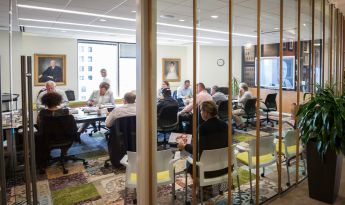
Photo by Greg Helgeson.
Where are you from?
I was born in Rochester, Minnesota, and later moved to Fargo, North Dakota. I see myself as a North Dakota kid. Growing up in Fargo was fantastic. It’s a prosperous community with three colleges, and I had access to many opportunities, even though it is in one of the least populated U.S. states. I claim my North Dakota roots very proudly, partly because a lot of people don’t — what’s up with that? It’s fantastic to be from North Dakota!
"I’ve seen the Foundation make remarkable progress on diversity, equity and inclusion work."
Pam Moret
How did you come to the Foundation?
Serving on a variety of boards was always one of my career goals, and I’ve been privileged to see that become a reality. It was a delightful surprise to be nominated to serve on the Bush Foundation’s Board. The Foundation’s work was fascinating to me, and I’ve always felt foundations are a very interesting tool for global change. When I went to my interview, I didn’t expect to be chosen — when you look at the people on the board, they’re rock stars. I was so honored to be selected, and it was immediately captivating. I got a crash course in the Bush Foundation, philanthropy in general and the needs of our region.
How do you approach your role as Board Chair?
There is a saying about effective boards: When board members are doing a good job, they have their “noses in and fingers out" (NIFO, a play on the accounting term LIFO). That means that you need to know what’s going on and how things are going, but you are not running the organization. That is an art, not a science! I work very closely with Foundation President Jen Ford Reedy, and the two of us are extremely open with one another. As I work with Jen and the other board members, I am always trying to maintain that balance of being engaged at the right level to be effective.
What’s one success you’ve seen during your tenure?
I’ve seen the Foundation make remarkable progress on diversity, equity and inclusion work. There is a genuine and thoughtful way in which we are laying a foundation of training and conversation around equity and cultural competency for the board and staff, and that is coming through in relationships between staff, grantees and community members. Jen is pushing us to be authentic, committed, and really put our money where our mouth is. We’ve come a long way, and we’re not stopping.
What’s one thing you’re taking away from your experience at the Foundation?
There’s an axiom I truly believe: “If you find you’re the smartest person in the room, you’re in the wrong room.” When I sit in the Foundation’s board room, with grantees, or with staff, I am never the smartest person in the room. I have learned constantly from so many smart people, and have been exposed to much more than I would have otherwise. I wouldn’t have spent time kicking around the streets of Rapid City, South Dakota, or traveled to an oil field “man camp” in western North Dakota, or visited the Red Lake Nation — or all the other hidden gems in our region that I wasn’t aware of, even though I am from here. I’m a richer person for having had those experiences. And that’s pretty cool.
